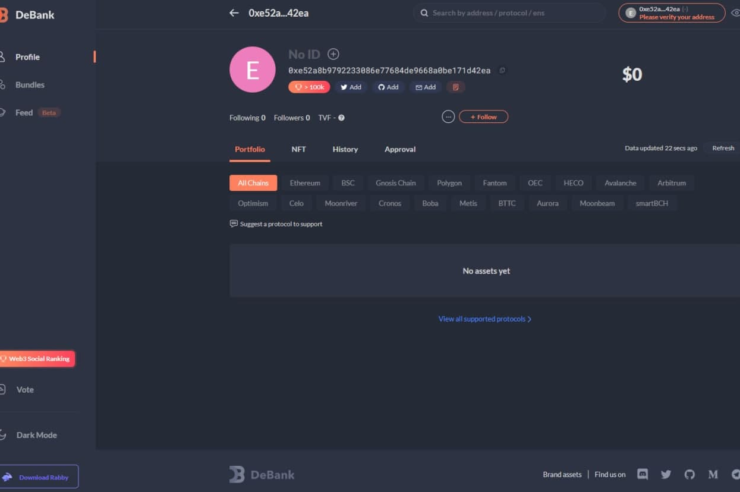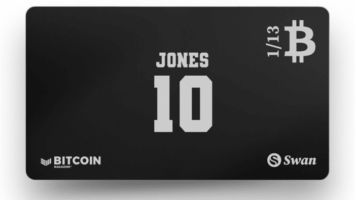The cryptocurrency ecosystem has seen a tremendous amount of growth over the past couple of years, as the introduction of decentralized finance (DeFi) and the popularity of nonfungible tokens (NFT) have led to an explosion of projects on more than a dozen blockchain networks.
The rapidly growing ecosystem means investors have to keep track of multiple wallet addresses, making portfolio trackers a popular option for traders needing to manage a diverse multichain portfolio.
Here are three portfolio-tracking decentralized applications, or DApps, crypto traders can use to help monitor their investments.
Zapper
Zapper supports the basic management of cryptocurrencies held on 11 different networks including Ethereum, Polygon, BNB Chain, Fantom, Avalanche and Optimism.
The basic layout of the homepage provides information about the various protocols that the connected wallet is currently engaged with, and it also gives a breakdown of the value of assets held on each of the supported networks.


Users can perform token swaps through a basic swap interface that integrates with liquidity on decentralized exchanges such as Uniswap, Pangolin and QuickSwap, and they can also use the bridging feature to transfer assets between the supported chains.
Traders can also deposit assets to pools on protocols integrated with Zapper, such as SushiSwap, PancakeSwap, Curve, Aave and Compound.
Other integrations include yield farming options and the ability to deposit assets into vaults on Yearn.finance.
Portfolio managers that are similar to Zapper include Zerion, Instadapp and DeFi Saver.
NFTBank
NFTBank is a free-to-use portfolio tracker that is specifically designed to help users manage their NFT holdings by providing a variety of tools to help with tracking and research.
The main portfolio interface offers a simple breakdown of the profits and losses of the NFTs in the connected wallet by detailing the total revenue, total spending, return on investment and current inventory value of the assets held.


The front page also includes a simplified yearly calendar that indicates what days had the heaviest activity for the wallet or group of wallets in question, and there is the option to share a screenshot of the portfolio’s progress via social media.
Users can see a more detailed breakdown of their holdings, track the performance of each asset, access an activity log for all interactions with different collections, and download tax filing documents to report earnings to appropriate government organizations.
NFTBank also offers an NFT explorer that is capable of searching through collections on Ethereum, Klaytn, Ronin and Polygon to view data on current and previous floor prices, percentage change, 30-day volume and the daily number of newly listed NFTs in each collection.
A price search feature allows users to search 1,222 different collections to find the “deal of the day,” and it breaks them down by estimated price, floor price, listing price, rarity rank and an overpriced/underpriced rating.
NFT trackers that are comparable to NFTBank include the DappRadar portfolio tracker, ArtCentral.io and Value.app.
DeBank
DeBank is a more advanced interface that helps DeFi investors manage their holdings across 19 separate blockchain networks, including Ethereum, BNB Chain, Polygon, Chronos and HECO.


The main interface for DeBank gives a breakdown of the value held on each network, and users can also see a deeper analysis of the amount held and staked in each wallet and across DeFi and NFT platforms.
DeBank’s NFT section currently supports 414 collections on the Ethereum network, and it provides basic information such as the name of the specific NFT and its floor price.
One feature that comes in handy for active DeFi users is the Token Approval section of DeBank, which lists all the different contract approvals active for the connected wallet, the amount approved and a breakdown of the risk exposure.
– Keep in mind that u can manage your token approval permissions @DeBankDeFi with straightforward UI:
1. Decline untrusted ones
2. Search to verifyhttps://t.co/XpcpO0VdCi https://t.co/7O6xLAwrIn pic.twitter.com/RXlMPWy28l— DeBank (@DeBankDeFi) February 28, 2021
Using the Token Approval Management tool, users can decline any currently approved contracts directly through DeBank.
The platform includes a “Feeds” section, which is a social function that allows users to follow other users who have high Web3 Social Rankings to track their latest trades, NFT purchases and social commentary.
DeBank also offers a “DeFi List” that includes data on more than 1,165 different protocols spread across all the supported networks and breaks them down by tags, such as yield aggregator, decentralized exchange, options or NFT, and it provides information on total user deposits and the number of active users in the past 24 hours.
Portfolio trackers similar to DeBank include Ape Board, Zerion and Tin.network.
Want more information about trading and investing in crypto markets?
The views and opinions expressed here are solely those of the author and do not necessarily reflect the views of Cointelegraph.com. Every investment and trading move involves risk, you should conduct your own research when making a decision.






















Comments (No)